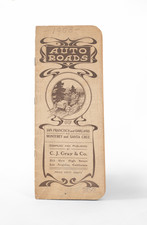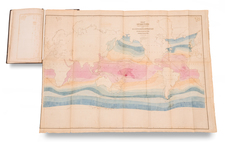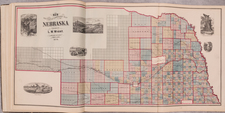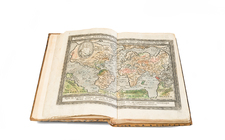With the First Obtainable Map of North America.
One of the finest Italian books from the "isolario" genre and the first to be illustrated with copperplate engraved maps.
The book includes forty-seven fantastic maps showing all parts of the world, starting with the Mediterranean but expanding to Asia and North America. The book terminates with two lovely world maps (and, strangely, a map of Istria), one of which is a classic oval-shaped world map and the other a navigational map of the world. The maps are supplemented by lengthy and interesting Italian text that always opens with an attractive historiated initial.
The style of the maps is following the distinct Lafreri School Italian tendencies of the latter half of the 16th century. Mountains are noticeably rounded (rather than the pointier style of the 17th century) and the seas are uniformly stippled. Sea monsters, sailing ships, and cartouches appear on many of the maps.
This is the 1605 edition of the work. Porcacchi's Isolario was first published in 1572 with 30 maps before being enlarged in the second 1576 edition.
Porcacchi's Mondo Nuovo
The map includes a nice example of the earliest obtainable map of North America (first published in 1572), which is preceded only by Paolo Forlani's rare 1565 map of North America.
The Forlani map includes many firsts which were repeated in the Porcacchi map, including the first detailed depiction of the Straits of Anian. The map reflects the second Cartier voyage and early Spanish explorations in the Southwest, most notably Coronado's expedition. The treatment of the West Coast of North America, Baja California, and the misdirected lake at the head of the St. Lawrence River are noteworthy.
A Brief History of Isolarii
The Isolario genre dates to the 1420's, when Cristoforo Buondelmonti first executed his Liber insularum archipelago following six years of travels through the eastern Mediterranean. While not always the most accurate, Buondelmonti's work was widely reproduced, with some changes made, and dominated the market for island-books for most of the rest of the 15th century. The first printed isolario, by Bartolomeo da li Sonetti, was heavily derived from Buondelmonti's work.
The sixteenth century saw the isolario genre expand out of a Mediterranean focus, with the first "global" isolario appearing in Venice in 1528. It was this genre of isolario that dominated into the 17th century and it is to this genre that Porcacchi's work belongs.
These island-books were remarkable for a number of reasons. Firstly, they displayed a remarkable interplay between manuscript and printed versions, with each format heavily influencing the other. Secondly, the books were not intended as a purely geographical work, and many were staggeringly inaccurate. They were, instead, supposed to be objects of contemplation from their inception, meant to spur the Medieval and Renaissance mind into imagining far-flung portions of the world. This was apparent in the earliest manuscript and printed isolarios. Da li Sonetti's incunable version of Buondelmonti's text was published in terza rima following Dante's Commedia, and Porcacchi's Isolario reflects this tradition with its poetic descriptions.
Provenance
With the collector's stamp on the title reading "Bibliotheque de Me Vincentelli Avoue Agrege Bastia." The Vincentelli's are an old Corsican family whose descendants still live in and around Bastia, on the northeastern coast of the island.
Collation
[24]; 1-211.












![[ Ethnographic Thematic Atlas - Poland, Lithuania, Ukraine, etc. ] Völker-Verteilung in West-Russland (Distribution of Peoples in Western-Russia)](https://storage.googleapis.com/raremaps/img/small/94045.jpg)

![Theatrum Orbis Terrarum [with:] Parergon, Sive Veteris Geographiae Aliquot Tabulae [and:] Nomenclator](https://storage.googleapis.com/raremaps/img/small/92703.jpg)

